Resources, Conservation and Recycling ( IF 11.2 ) Pub Date : 2021-11-19 , DOI: 10.1016/j.resconrec.2021.106031 R. Sinha 1 , J.-B.E. Thomas 1 , Å. Strand 2 , T. Söderqvist 3, 4 , J. Stadmark 5 , F. Franzen 6 , I. Ingmansson 6 , F. Gröndahl 1 , L. Hasselström 1

|
Anthropogenic consumption of nitrogen (N) and phosphorus (P) has pushed their respective planetary boundaries beyond a safe operating space causing environmental problems, and simultaneously, the depletion of finite mineral P resources is of growing concern. Previous research has found that marine biomass such as kelp, reed and mussels have a high potential for taking up N and P, which could potentially contribute both to alleviating environmental problems and recirculating P from marine environments back to human consumption systems. This paper thus examines these nutrient flows and the extent to which marine biomass can contribute to close the loop. The study utilizes an element flow analysis (EFA) to establish the mapping of N and P flows and explore plausible scenarios of biomass utilisation by 2030 and 2050 for P loop closure in Sweden. The current uptake of P and N through the seven marine biomass cases (mariculture of mussels on both the Swedish east and west coasts, kelp and ascidians and the harvest of wild oysters, beach-cast and reed) contributes to 1.1% and 0.3% respectively of the full loop closure (relative to 2016 loading). Approximately 22% of the total P (and 23% N) uptake (in the biomasses) is currently being used in products, while the rest remains unused. The plausible future scenario for 2050 expects to contribute to around 10% P and 2.8% N loop closure (relative to 2016) if all nutrients in the uptake are used.
中文翻译:

通过元素流分析量化养分回收:收获和使用七种海洋生物质来关闭 N 和 P 循环
氮 (N) 和磷 (P) 的人为消耗已将它们各自的行星边界推到安全操作空间之外,从而导致环境问题,同时,有限矿物 P 资源的枯竭越来越受到关注。先前的研究发现,海带、芦苇和贻贝等海洋生物质吸收 N 和 P 的潜力很大,这可能有助于缓解环境问题,并将 P 从海洋环境循环回人类消费系统。因此,本文研究了这些养分流动以及海洋生物量可以在多大程度上促成闭合循环。该研究利用元素流分析 (EFA) 建立 N 和 P 流的映射,并探索到 2030 年和 2050 年瑞典 P 循环闭合的生物质利用的合理情景。目前通过七个海洋生物量案例(瑞典东海岸和西海岸的贻贝、海带和海鞘的海水养殖以及野生牡蛎、海滩投掷和芦苇的收获)对磷和氮的吸收分别占 1.1% 和 0.3%全环闭合(相对于 2016 年加载)。大约 22% 的总磷(和 23% 的氮)吸收(在生物质中)目前用于产品,而其余的仍未使用。如果吸收中的所有养分都被使用,2050 年可能的未来情景预计将贡献大约 10% 的 P 和 2.8% 的 N 环路闭合(相对于 2016 年)。分别为全环闭合的 3%(相对于 2016 年加载)。大约 22% 的总磷(和 23% 的氮)吸收(在生物质中)目前用于产品,而其余的仍未使用。如果吸收中的所有养分都被使用,2050 年可能的未来情景预计将贡献大约 10% 的 P 和 2.8% 的 N 环路闭合(相对于 2016 年)。分别为全环闭合的 3%(相对于 2016 年加载)。大约 22% 的总磷(和 23% 的氮)吸收(在生物质中)目前用于产品,而其余的仍未使用。如果吸收中的所有养分都被使用,2050 年可能的未来情景预计将贡献大约 10% 的 P 和 2.8% 的 N 环路闭合(相对于 2016 年)。











































 京公网安备 11010802027423号
京公网安备 11010802027423号